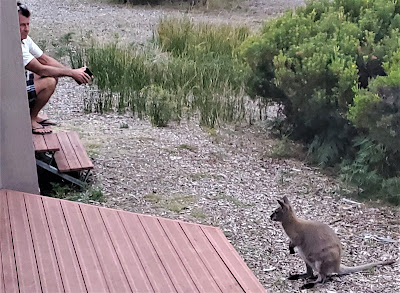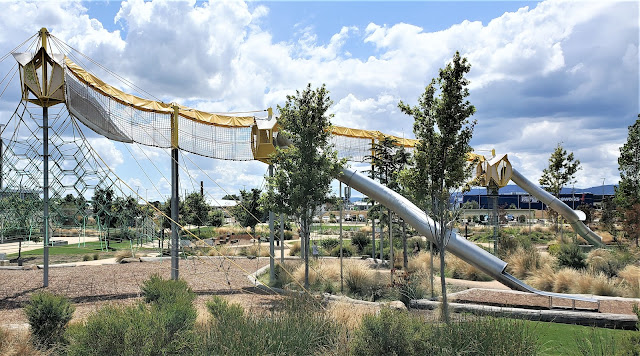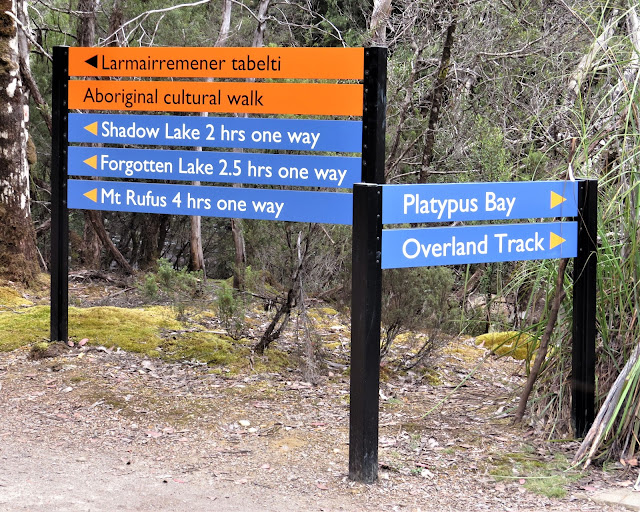 |
| This is the beach off our room at Edge of the Bay, a small hotel near Freycinet National Park. |
Friends who have lived and travelled extensively in Austalia are very big on Tasmania, the large island between Australia and Antactica. During a several-week trip to New Zealand, my wife, Jane, and I set aside 10 days to hop over the Tasman Sea to Tasmania.
We flew Air New Zealand on Sunday, Feb. 5, 2023, from Auckland to Hobart, the capital and largest city of Tasmania, We stayed three nights on the harbor there at MACq 01, a large "strory-telling" hotel. Hobart is a pleasant enough town but its most unusual attraction is a bit out of town: the Museum of Old and New Art. One of our two full days in Hobart was devoted to the museum. More on Hobart.
Next we headed north to Freycinet National Park, which occupies a peninsula with some of Tasmania's best beaches and seascapes. We stayed two nights at Edge of the Bay, where we were visited by a wallaby, and which has a stunning beach (photo at top of this post) and a very good fine-dining restaurant called the Lure. The Freycinet area has two main attractions, the park's much-touted Wineglass Bay and Freycinet Marine Farm, which grows oysters and mussels that it serves at its lunch-only seafood patio. There's also crayfish (lobster) and other seafood, but oysters and mussels are the stars. More on Freycinet.
Wine was on our minds more than seafood as we headed west to Launceston, which is surrounded by Tamar Valley vineyards and wineries. Here we stayed three nights at Peppers Silo, a hotel fashioned from a huge grain silo stucture where the North Esk River flows into the River Tamar. We devoted one day to a wineries tour (tasting rooms are called "cellar doors") and another day to exploring the South Esk River gorge. More on the Tamar Valley.
Our next stop was two nights at Lake St. Clair, a large deep-water lake (Australia's deepest at 215 meters or 705 feet) on the approach to Cradle Mountain, a popular hiking destination. The multiple-day Overland Track (trail) connects the mountain and the lake. We stayed on the lake, literally, way out on a pier in a giant converted pumping station called Pumphouse Point. Platypus reportedly live in the lake -- there's even a platypus viewing blind at Platypus Bay -- but we didn't see any and a hotel employee said that in his five years there he had not seen any of the unique nocturnal creatures. (We have, however, seen them at the San Diego Zoo Safari Park, the only place in the world to see them other than Australia.) More on Lake St. Clair.
Then it was back to Hobart, where we stayed a night at the Henry Jones Art Hotel, across the street from its sibling hotel, the MACq 01. A mid-day flight Thursday, Feb. 16, 2023, took us back to Auckland and we resumed our New Zealand adventure.
Here are a few Tasmania snapshots:
 |
| This tunnel, which visitors walk through, is one of many mind-bending installations at the Museum of Old and New Art in Hobart. |
 |
| A wallaby visits our hotel room's deck at Edge of the Bay in Freycinet. A guest in the room nextdoor watches. |
 |
| What I think is a gum tree adorns the trail to Wineglass Bay at Freycinet. |
 |
| My 5-year-old granddaugher would love this gigantic play structure in a park at Launceston. The riverfront park partially wrapped around Peppers Silo Hotel where we stayed. |
 |
| A tasting room hostess pours tastings for our wine tour group at Velo, a winery in the Tamar Valley. We rode in a van with a few other people and visited four celler doors for tastings and lunch. |
 |
| Signs show that Lake St. Clair is a place for hiking. We did the Aboriginal cultural walk, the trail to Platypus Bay, and a short segment of the Overland Track. |
 |
| The roots of these two giants seem to have naturally grafted onto each other. This is on the Aborginal cultural walk at Lake St. Clair. |
Driving in Australia
We picked up a Hertz rental car at the Hobart airport for my first time driving on the left side of the road in over a decade. It was a new KIA Cerato, which is sold in the U.S. as the Forte. Driving a car with the steering wheel on the right and other functions reversed from what I'm used to in the U.S. meant I kept activating the wipers when I tried to signal for a turn. It took a while to get comfortable with two-lane roads and vehicles coming toward me on my right. At traffic circles, which are called roundabouts here, the traffic flows clockwise, the opposite from in the U.S. and mainland Europe. For me, right turns were where I was most likely to end up in the wrong lane, but I only did that a couple of times and there was, fortunately, no oncoming traffic.
We had planned to use smartphone GPS for driving directions, but we carelessly had a locked phone and could not put in an Australian sim card. So we used wi-fi and screen-saved step-by-step directions on our phones. This worked well everywhere except Launceston, where an appalling lack of street signs had us wandering the city for about an hour before we found the right way out of town.


No comments:
Post a Comment